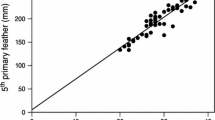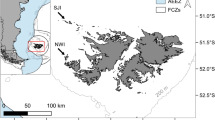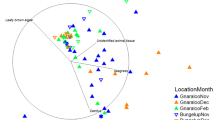Abstract
The Glaucous-winged gull (Larus glaucescens) has been selected by Environment Canada as a marine indicator species for long-term monitoring of persistent contaminants in the Canadian Pacific. However, the indicator value of this species depends on its trophic level and proportion of marine prey in its diet. Eggs, used as the monitoring medium, are produced entirely from maternal resources and knowledge of adult diet before and during egg production is critical to interpreting contaminant levels. Due to a lack of recent and reliable dietary ecology work, we examined the diet of breeding Glaucous-winged gulls through carbon (δ13C) and nitrogen (δ15N) stable isotope analysis at three colonies on the Pacific coast. Near-shore marine prey, occupying a high trophic level (δ15N), composed a predominant component of all Glaucous-winged gull diet. Adult diet composition from colonies in the Salish Sea was more varied than the west coast of Vancouver Island, reflecting the opportunistic foraging nature of this species in areas where the abundance of marine prey is known to fluctuate. Compared with incubating adults, pre-laying adults had a significantly lower trophic level that may reflect the need to consume marine invertebrates to acquire specific nutrients necessary for egg production. Interannual variation in both trophic level and prey source (δ13C) in egg and chick tissues indicates the need to pair ongoing contaminant monitoring with stable isotope analysis. The predominantly marine diet and relatively high trophic level of this gull supports its use as an indicator of marine pollution on the Pacific coast.


Similar content being viewed by others
References
Auman HJ, Bond AL, Meathrel CE, Richardson AMM (2011) Urbanization of the silver gull: evidence of anthropogenic feeding regimes from stable isotope analyses. Waterbirds 34:70–76. doi:10.1675/063.034.0108
Bearhop S, Teece MA, Waldron S, Furness RW (2000) Influence of lipid and uric acid on δ13C and δ15N values of avian blood: implications for trophic studies. Auk 117:504–507. doi:10.1642/0004-8038(2000)117[0504:IOLAUA]2.0.CO;2
Becker PH (1989) Seabirds as monitor organisms of contaminants along the German North Sea coast. Helgol Meeresunters 43:395–403. doi:10.1007/BF02365899
Becker PH (2003) Chapter 19 biomonitoring with birds. In: Market BA, Breure AM, Zechmeister HG (eds) Bioindicators & biomonitors: principles, concepts and applications. Elsevier, London, pp 677–736
Blight LK (2012) Glaucous-winged gulls (Larus glaucescens) as sentinels for a century of ecosystem change—long-term trends in population, diet, and egg production in North America’s Salish Sea. Ph.D. thesis, University of British Columbia
Chen D, Letcher RJ, Burgess NM et al (2012) Flame retardants in eggs of four gull species (Laridae) from breeding sites spanning Atlantic to Pacific Canada. Environ Pollut 168:1–9. doi:10.1016/j.envpol.2012.03.040
Davis ML, Elliott JE, Williams TD (2015) Spatial and temporal variation in the dietary ecology of the Glaucous-winged gull Larus glaucescens in the Pacific Northwest. Mar Ornithol 43:189–198
Elliott JE, Elliott KH (2013) Tracking marine pollution. Science 340:556–558
Elliott KH, Elliott JE (2016) Origin of sulfur in diet drives spatial and temporal mercury trends in seabird eggs from Pacific Canada 1968−2015. Environ Sci Technol 50(24):13380–13386. doi:10.1021/acs.est.6b05458
Elliott JE, Wilson LK, Wakeford B (2005) Polybrominated diphenyl ether trends in eggs of marine and freshwater birds from British Columbia, Canada, 1979–2002. Environ Sci Technol 39:5584–5591. doi:10.1021/es050496q
Elliott KH, Cesh LS, Dooley JA et al (2009) PCBs and DDE, but not PBDEs, increase with trophic level and marine input in nestling bald eagles. Sci Total Environ 407:3867–3875. doi:10.1016/j.scitotenv.2009.02.027
Evans Ogden LJ, Hobson KA, Lank DB, Bittman S (2005) Stable isotope analysis reveals that agricultural habitat provides an important dietary component for nonbreeding dunlin. Avian Conserv Ecol 1:3
Fox G, Allan L, Weseloh D, Mineau P (1990) The diet of herring gulls during the nesting period in Canadian waters of the Great Lakes. Can J Zool 68:1075–1085. doi:10.1139/z90-159
Furness R, Camphuysen KCJ (1997) Seabirds as monitors of the marine environment. ICES J Mar Sci 54:726. doi:10.1006/jmsc.1997.0243
Gebbink WA, Letcher RJ, Burgess NM et al (2011) Perfluoroalkyl carboxylates and sulfonates and precursors in relation to dietary source tracers in the eggs of four species of gulls (Larids) from breeding sites spanning Atlantic to Pacific Canada. Environ Int 37:1175–1182. doi:10.1016/j.envint.2011.04.003
Gilbane L (2006) Macrophyte contributions to Mytilus californianus diets in southern California as determined by carbon and nitrogen stable isotope ratios. M.Sc. thesis, California State University
Gilbertson M, Elliott JE, Peakall DB (1987) Seabirds as indicators of marine pollution. In: Diamond AW, Filion FL (eds) The value of birds. International Council for Bird Preservation, Cambridge, pp 231–248
Hatch SA, Gill VA, Mulcahy DM (2011) Migration and wintering areas of glaucous-winged gulls from South-Central Alaska. Condor 113:340–351. doi:10.1525/cond.2011.090224
Hebert CE, Shutt JL, Hobson KA, Weseloh DVC (1999) Spatial and temporal differences in the diet of Great Lakes herring gulls (Larus argentatus): evidence from stable isotope analysis. Can J Fish Aquat Sci 56:323–338. doi:10.1139/f98-189
Hebert CE, Hobson KA, Shutt JL (2000) Changes in food web structure affect rate of PCB decline in herring gull (Larus argentatus) eggs. Environ Sci Technol 34:1609–1614. doi:10.1021/es990933z
Hebert CE, Weseloh DVC, Idrissi A et al (2008) Restoring piscivorous fish populations in the Laurentian Great Lakes causes seabird dietary change. Ecology 89:891–897. doi:10.1890/07-1603.1
Hebert CE, Weseloh DVC, Gauthier LT et al (2009) Biochemical tracers reveal intra-specific differences in the food webs utilized by individual seabirds. Oecologia 160:15–23. doi:10.1007/s00442-009-1285-1
Henderson BA (1972) The control and organization of parental feeding and its relationships to the food supply for the glaucous-winged gull, Larus glaucescens. M.Sc. thesis, University of British Columbia
Hill JM, McQuaid CD (2008) δ13C and δ15N biogeographic trends in rocky intertidal communities along the coast of South Africa: evidence of strong environmental signatures. Estuar Coast Shelf Sci 80:261–268. doi:10.1016/j.ecss.2008.08.005
Hobson KA, Clark RG (1992) Assessing avian diets using stable isotopes I: turnover of 13C in tissues. Condor 94:181–188. doi:10.2307/1368807
Hobson KA, Clark RG (1993) Turnover of 13C in cellular and plasma fractions of blood: implications for nondestructive sampling in avian dietary studies. Auk 110:638–641. doi:10.2307/4088430
Hobson KA, Welch HE (1992) Determination of trophic relationships within a high Arctic marine food web using δ13C and δ15N analysis. Mar Ecol Prog Ser 84:9–18
Hobson KA, Piatt JF, Pitocchelli J (1994) Using stable isotopes to determine seabird trophic relationships. J Anim Ecol 63:786–798
Houston DC, Jones PJ, Sinly RM (1983) The effect of female body condition on egg laying in Lesser black-backed gulls Larus fuscus. J Zool 200:509–520. doi:10.1111/j.1469-7998.1983.tb02812.x
Inger R, Bearhop S (2008) Applications of stable isotope analyses to avian ecology. Ibis 150:447–461. doi:10.1111/j.1474-919X.2008.00839.x
Jarman WM, Hobson KA, Sydeman WJ et al (1996) Influence of trophic position and feeding location on contaminant levels in the Gulf of the Farallones food web revealed by stable isotope analysis. Environ Sci Technol 30:654–660. doi:10.1021/es950392n
Knoff AJ, Macko SA, Erwin RM, Brown KM (2002) Stable isotope analysis of temporal variation in the diets of pre-fledged laughing gulls. Waterbirds 25:142–148. doi:10.1675/1524-4695(2002)025[0142:SIAOTV]2.0.CO;2
Liebezeit JR, Smith PA, Lanctot RB et al (2007) Assessing the development of shorebird eggs using the flotation method: species-specific and generalized regression models. Condor 109:32–47. doi:10.1650/0010-5422(2007)109[32:ATDOSE]2.0.CO;2
Meijer T, Drent R (1999) Re-examination of the capital and income dichotomy in breeding birds. Ibis 141:399–414. doi:10.1111/j.1474-919X.1999.tb04409.x
Michener RH, Schell DM (1994) Stable isotopes as tracers in marine aquatic food webs. In: Michener RH, Lajtha K (eds) Stable isotopes in ecology and environmental science. Blackwell Scientific Publications, Oxford, pp 138–157
Miller A, Elliott JE, Elliott KH et al (2014) Spatial and temporal trends in brominated flame retardants in seabirds from the Pacific Coast of Canada. Environ Pollut 195C:48–55. doi:10.1016/j.envpol.2014.08.009
Miller A, Elliott JE, Elliott KH et al (2015) Brominated flame retardant trends in aquatic birds from the Salish Sea region of the west coast of North America, including a mini-review of recent trends in marine and estuarine birds. Sci Total Environ 502:60–69. doi:10.1016/j.scitotenv.2014.09.006
Mills JA, Ryder JP (1979) Trap for capturing shore and seabirds. Bird-Band 50:121–123
Minagawa M, Wada E (1984) Stepwise enrichment of 15N along food chains: further evidence and the relation between δ15N and animal age. Geochim Cosmochim Acta 48:1135–1140. doi:10.1016/0016-7037(84)90204-7
Moreno R, Jover L, Munilla I et al (2010) A three-isotope approach to disentangling the diet of a generalist consumer: the yellow-legged gull in northwest Spain. Mar Biol 157:545–553. doi:10.1007/s00227-009-1340-9
Murphy EC, Day RH, Oakley KL, Hoover AA (1984) Dietary changes and poor reproductive performance in Glaucous-winged gulls. Auk 101:532–541
Pierotti R, Annett CA (1987) Reproductive consequences of dietary specialization and switching in an ecological generalist. In: Kamil A, Krebs J, Pulliam R (eds) Foraging behavior. Plenum Press, New York, pp 417–442
Pierotti R, Annett CA (1991) Diet choice in the herring gull: constraints imposed by reproductive and ecological factors. Ecology 72:319–328. doi:10.2307/1938925
Post DM (2002) Using stable isotopes to estimate trophic position: models, methods, and assumptions. Ecology 83:703–718. doi:10.1890/0012-9658(2002)083[0703:USITET]2.0.CO;2
Ramírez F, Ramos R, Carrasco JL et al (2011) Intra-clutch pattern of albumen δ13C and δ15N in yellow-legged gulls Larus michahellis: female dietary shift or resource allocation strategy? J Avian Biol 42:239–246. doi:10.1111/j.1600-048X.2011.05262.x
Sears J, Hatch SA, O’Brien DM (2009) Disentangling effects of growth and nutritional status on seabird stable isotope ratios. Oecologia 159:41–48
Sharp CM, Abraham KF, Burness G (2009) Embryo development influences the isotopic signatures of egg components in incubated eggs. Condor 111:361–365. doi:10.1525/cond.2009.090011
Tieszen LL, Boutton TW, Tesdahl KG, Slade NA (1983) Fractionation and turnover of stable carbon isotopes in animal tissues: implications for δ13C analysis of diet. Oecologia 57:32–37. doi:10.1007/BF00379558
Vermeer K (1963) The breeding ecology of the Glaucous-winged gull (Larus glaucescens) on Mandarte Island, B.C. M.Sc. Thesis, University of Britsh Columbia
Vermeer K (1982) Comparison of the diet of the Glaucous-winged gull on the east and west coasts of Vancouver Island. Murrelet 63:80–85
Vermeer K, Devito K (1987) Habitat and nest-site selection of mew and glaucous-winged gulls in coastal British Colombia. Stud Avian Biol 10:105–118
Ward JG (1973) Reproductive success, food supply, and the evolution of clutch-size in the glaucous-winged gull. Ph.D. thesis, University of British Columbia
Acknowledgments
This study was funded by the Chemical Management Plan of Environment and Climate Change Canada (ECCC), and contributions from the Science and Technology Branch of ECCC, and the Centre for Wildlife Ecology, Simon Fraser University. The authors thank the many people involved in the egg collection, particularly Sandi Lee, other logistical support, and valuable input on seabird isotope ecology.
Author information
Authors and Affiliations
Corresponding author
Rights and permissions
About this article
Cite this article
Davis, M.L., Elliott, J.E. & Williams, T.D. The Glaucous-Winged Gull (Larus glaucescens) as an Indicator of Chemical Contaminants in the Canadian Pacific Marine Environment: Evidence from Stable Isotopes. Arch Environ Contam Toxicol 73, 247–255 (2017). https://doi.org/10.1007/s00244-017-0368-y
Received:
Accepted:
Published:
Issue Date:
DOI: https://doi.org/10.1007/s00244-017-0368-y




